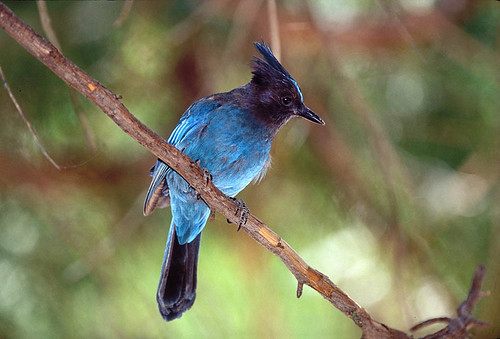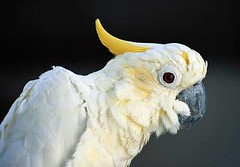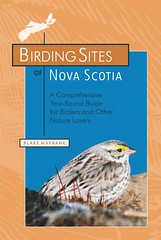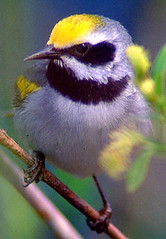Birds in the News #39

Steller's Jay, Cyanocitta stelleri
Birds in Science
A Canadian researcher says the title of most innovative birds goes to crows and jays, such as the Steller's Jay, Cyanocitta stelleri, (pictured above) -- a judgement based on observed novel feeding techniques. Corvids were followed by falcons, hawks, herons, and woodpeckers with regards to innovative feeding techniques. The avian innovation index is based on 2,000 reports of feeding "innovations" observed in the wild and published in ornithology journals over a period of 75 years. "We gathered as many examples as we could from the short notes of ornithology journals about the feeding behaviours that people had never seen or were unusual," said Dr Louis Lefebvre, of McGill University in Montreal, Canada. Dr Lefebvre, the test's creator, was surprised that parrots were not high in the pecking order - despite their relatively large brains. This work was presented to the annual meeting of the American Association for the Advancement of Science (AAAS). [original paper (PDF)]. GrrlScientist comment: you will notice that the news story claims this is an avian IQ, or intelligence, index, but it is not. Intelligence is more multifaceted than just innovative feeding behaviors. Additionally, since this index is based on observer reports of feeding behaviors, that means the birds had to be observable while feeding. Of course, that could explain why parrots ranked much lower than expected since they tend to feed in the canopy, where they are difficult to see. Also, tropical birds -- which include parrots -- are poorly known, particularly when compared to North American birds.
Scientists working with the 52 member organizations of the Alliance for Zero Extinction recently published a study that identifies 794 species threatened with imminent extinction, each of which is in need of urgent conservation action at a single remaining site on Earth. While extinction is a natural process, the authors note that current human-caused rates of species loss are 100-1,000 times greater than natural rates. In recent history, most species extinctions have occurred on isolated islands following the introduction of invasive predators such as cats and rats. This study shows that the extinction crisis has now expanded to become a full-blown assault on Earth’s major land masses, with the majority of at-risk sites and species now found on continental mountains and in lowland areas. Their recommendation is to protect 595 sites around the world to help stave off an imminent global extinction crisis. This research was published this week in the top-tier peer-reviewed journal, Proceedings of the National Academy of Sciences. [abstract, and the full paper free via open access].
People Helping Birds
 The Australian Government's Regional Natural Heritage Programme (RNHP) has awarded AU$193,000 to identify conservation priorities and build partnerships for managing Timor-Leste's first national park. (Timor-Leste was formerly known as East Timor and has been officially independent since 2002.) The project will focus on the area with the highest biodiversity value in East Timor, to build partnerships and collaboratively identify conservation priorities and objectives. It will establish a foundation for community-based conservation via a national protected areas network. The first area of focus on will be the Lore/Lake Iralalaro/Jaco Island region, including three Important Bird Areas (IBA) with populations of the Critically Endangered Sulfur-crested Cockatoo, Cacatua sulphurea (pictured), the Endangered Timor Green-pigeon, Treron psittaceus, and several Near Threatened and endemic species. "The creation of East Timor's first national park is an important step for conservation in the country. The Australian Government are to be congratulated on helping to protect the biodiversity of their close neighbors," said Richard Grimmett, Head of BirdLife's Asia Division. BirdLife will manage this project.
The Australian Government's Regional Natural Heritage Programme (RNHP) has awarded AU$193,000 to identify conservation priorities and build partnerships for managing Timor-Leste's first national park. (Timor-Leste was formerly known as East Timor and has been officially independent since 2002.) The project will focus on the area with the highest biodiversity value in East Timor, to build partnerships and collaboratively identify conservation priorities and objectives. It will establish a foundation for community-based conservation via a national protected areas network. The first area of focus on will be the Lore/Lake Iralalaro/Jaco Island region, including three Important Bird Areas (IBA) with populations of the Critically Endangered Sulfur-crested Cockatoo, Cacatua sulphurea (pictured), the Endangered Timor Green-pigeon, Treron psittaceus, and several Near Threatened and endemic species. "The creation of East Timor's first national park is an important step for conservation in the country. The Australian Government are to be congratulated on helping to protect the biodiversity of their close neighbors," said Richard Grimmett, Head of BirdLife's Asia Division. BirdLife will manage this project. Birders Helping Birders
 Would you like to help test drive a unique new web site for birders? Blake Maybank created Birding Sites of Novia Scotia in conjunction with his recently published book with the same name, and he is asking for your assistance by "test driving" it. The site is designed to augment and support the birding guide by helping prospective visitors plan and organise Nova Scotia birding trips. This site contains links to information that, for a variety of reasons, was impractical or impossible to place on the printed page, including trip-planning sources (tourism and orientation sites); daily weather, tide, and road information; species' lists for birding sites described in the book; maps for the inside covers of the book (inadvertently left out during the printing process); links to provincial cultural resources, parks, natural areas, trails, and lighthouses; map links and satellite imagery for the birding sites and routes described in the book and links to other provincially-relevant natural history information. Blake wants to know if the site provides the sort of information that a travelling birder would need to plan a trip? Blake's contact information is included on the site itself so you can send him feedback directly.
Would you like to help test drive a unique new web site for birders? Blake Maybank created Birding Sites of Novia Scotia in conjunction with his recently published book with the same name, and he is asking for your assistance by "test driving" it. The site is designed to augment and support the birding guide by helping prospective visitors plan and organise Nova Scotia birding trips. This site contains links to information that, for a variety of reasons, was impractical or impossible to place on the printed page, including trip-planning sources (tourism and orientation sites); daily weather, tide, and road information; species' lists for birding sites described in the book; maps for the inside covers of the book (inadvertently left out during the printing process); links to provincial cultural resources, parks, natural areas, trails, and lighthouses; map links and satellite imagery for the birding sites and routes described in the book and links to other provincially-relevant natural history information. Blake wants to know if the site provides the sort of information that a travelling birder would need to plan a trip? Blake's contact information is included on the site itself so you can send him feedback directly. People Hurting Birds

This webpage documents two recent tower kills of migrating birds in Madison, Wisconsin. It includes lots of photographs of the towers and its feathery victims, a complete breakdown of species killed, a discussion of the event and links to other webbed towerkill reports. Particularly worrisome are the relatively large numbers of Golden-winged Warblers, Vermivora chrysoptera (pictured), found at the site. The five dead individuals reported represent almost 1% of the total GWWA picked up at communication towers in the eastern U.S. since monitoring has begun.
Bird Flu News
As the year draws to a close, millions of wild birds have flown to their wintering sites across, Asia, Africa, Europe and the Americas without the widely predicted outbreaks of H5N1 bird flu associated with their migration routes. "The most obvious explanation is that migrating wild birds are not spreading the disease," said Dr Michael Rands, Director & Chief Executive of BirdLife International. "Migratory wild birds were blamed for spreading bird flu west from Asia, yet there’s been no spread back eastwards, nor to South Asia and Africa this autumn. The limited outbreaks in eastern Europe are on southerly migration routes but are more likely to be caused by other vectors such as the import of poultry or poultry products. The hypothesis that wild birds are to blame is simply far from proven," concluded Dr. Rands. "Wild birds occasionally come into contact with infected poultry and die: they are the victims not vectors of H5N1 bird flu."
Thanks to Mr. Bui Quang Anh, Director General of the Department of Animal Health at the Ministry of Agriculture and Rural Development, the Vietnamese Government has finally come to their collective senses. After receiving an official letter written by Mr. Bui, the Vietnamese Government ordered an immediate halt to the culls of wild birds in Ho Chi Minh City, and the cities of Da Nang and Hue. Mr. Bui sent his letter to the three cities, saying: "The killing of pigeons and wild birds is not a national policy. This practice is not only an inappropriate measure but is also likely to cause bad effects to the ecosystem. Some international organisations have already expressed their great concerns regarding this practice. The Department of Animal Health at the Ministry of Agriculture and Rural Development has therefore requested Provincial Departments of Animal Health to advise Provincial Departments of Agriculture and Rural Development, Provincial People's Committees to stop the killing of pigeons and wild birds." City authorities had embarked on the culls, using poison and guns, in an attempt to prevent the spread of avian flu from the countryside.
The sudden death of more than 1,000 ducks at a lake in Mexico was not caused by bird flu, the government said on Monday, but scientists are still trying to uncover the reason that the birds mysteriously died. An Agriculture Ministry spokesman said that the condition of the dead birds, found by a lake in central Aguascalientes state, showed they had been dying over a period of days or weeks. Scientists are trying to determine if the birds died of botulism, a rare but deadly illness caused by a toxic bacteria, or from pollution, the ministry said. Incidentally, also mentioned in this story is that some Mexican environmental activists say that H5N1 could enter the country via a thriving trade, both illegal and legal, in exotic birds such as parrots. GrrlScientist says; I am frustrated that these activists are so concerned about the parrot trade but no mention is ever made of a much more likely vector for avian influenza; cockfighting birds.
Streaming Birds
 On BirdNote, for the week of December 12, they discuss the Christmas Bird Count; the sad tale of the Dodo, Raphus cucullatues; what birds do on a cold night; Who Was Townsend? and the majestic Gyrfalcon, Falco rusticolus. BirdNote programs are two-minute vignettes that incorporate the rich sounds of birds provided by Cornell University and by other sound recordists, with photographs and written stories that illustrate the interesting -- and in some cases, truly amazing -- abilities of birds. Some of the shows are Pacific Northwest-oriented, but many are of general interest. BirdNote can be heard live, Monday through Friday, 8:58-9:00AM in Western Washington state and Southern British Columbia on KPLU radio and now also in North Central Washington state on KOHO radio. All episodes are available in the BirdNote archives, both in written transcript and mp3 formats, along with photographs. [mp3/podcast].
On BirdNote, for the week of December 12, they discuss the Christmas Bird Count; the sad tale of the Dodo, Raphus cucullatues; what birds do on a cold night; Who Was Townsend? and the majestic Gyrfalcon, Falco rusticolus. BirdNote programs are two-minute vignettes that incorporate the rich sounds of birds provided by Cornell University and by other sound recordists, with photographs and written stories that illustrate the interesting -- and in some cases, truly amazing -- abilities of birds. Some of the shows are Pacific Northwest-oriented, but many are of general interest. BirdNote can be heard live, Monday through Friday, 8:58-9:00AM in Western Washington state and Southern British Columbia on KPLU radio and now also in North Central Washington state on KOHO radio. All episodes are available in the BirdNote archives, both in written transcript and mp3 formats, along with photographs. [mp3/podcast].Miscellaneous Birds
The January 2006 issue of the top-tier ornithological journal, AUK, will publish a 15 page commentary about the recent Ivory-billed Woodpecker rediscovery by Jerome Jackson, an expert on this species. It should be interesting to read, so keep your eyes open for it.
Although indirectly related to birds, this article describes the difficulties associated with reducing one's contribution to global warming while simultaneously reducing one's impact on environmental destruction. For example, some people are increasingly relying on bioenergy as an environmentally-safe alternative. Bioenergy is the energy generated from living plants and plant components (so-called "renewable biomass"). It has been hailed as one of the key weapons in the battle against global warming. However, without strong environmental safeguards in place, reduction in greenhouse gas emissions due to use of bioenergy will be negligible while impacts on the broader environment will be severe. "Travelling in a car fuelled by biodiesel seems like a great, environmentally-friendly thing to do. However, if the biodiesel has come from soya planted in the Brazilian Amazon or palm oil from Indonesia, the green consumer is likely to be unwittingly driving another nail into the coffin of the world's great ecosystems," observed Ariel Brunner, Agriculture Policy Officer at BirdLife International.
Thanks to my bird pals, Ian, Ellen and Ron, for some of the news story links that you are enjoying here. Thanks to Ian for catching my typographical errors.
tags: Birds in the News, ornithology, birds, avian, newsletter

Nominated (!!) to the Big Apple Blog Festival
Issue 20.
© 2004, 2005, 2006 by GrrlScientist











4 Peer Reviews:
Thanks for the round up of the bird news. Love that stellar's jay photo. We have a few jays that have been frequenting our feeder. DPR says he saw one perched on top of the suet feeder (above the flat feeder platform) do a forward roll down to the platform for food. Maybe not so inventive, but definitely playful!
Beautiful Stellers Jay photo...need more of them in print that show the stunning electric blue or white eyebrows.
In re birds being killed on structures - is it a stupid idea to suggest that structures be painted in UV paint? Maybe that would be more visible to the migrating birds? I realize corvids don't see in UV (they see in the violet, according to researchers), but I think passerines do? UV or deep violet colors would not be visible to humans but could save the birds?
Glad you're back, and good luck with the injury.
About those birds in Mexico - I've only heard of botulism in mishandled/ misprepared people food. Anybody have info on its occurence in the wild?
And "tropical birds - parrots - poorly known" - anybody know of available literature on wild parrot biology and behavior? Surely someone is researching them?!?
RD it's always so good to see you here! i think that steller's jay photo is one of the prettiest pictures i've ever seen of a bird, so i was thrilled to include it here.
it probably won't surprise you to know this but there are some studies out there that show a direct correlation between play and "intelligence" (mental plasticity).
Dr Fluffy Jones now, where would you have found such an .. interesting blognym?
thanks for the mary oliver poem, as you know, i love anything that she writes (just as i love anything that ansel adams photographed).
Chardyspal i have no idea if UV light is visible at night (i suspect it is not), but if it is visible, then it’s worth a try, don’t you think?
Jamie thanks for the good wishes. i am in a lot of pain, sometimes it threatens to overwhelm me.
to answer your questions, botulism poisoning of wild birds, especially waterfowl, is not unheard of. if i am not mistaken, the salton sea in california has seen its share of such events during the past ten years or so.
there are a few people researching wild parrots out there, but this is mostly in a conservation context.
wise crow i am interested to know what jerry jackson has to say, too. i am still curious to know why he was not included in the original search party ..
the AAAS publishes the top-tier journal, Science, and it is not at all easy to be published there. however, notice that this paper was presented to the annual AAAS meeting, which is not the same thing as publishing in the journal.
GrrlScientist
Post a Comment
<< Home